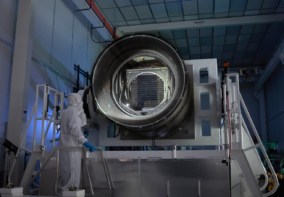***We hope you enjoyed our April Fool’s Day joke. You didn’t honestly believe any of this nonsense did you?***

A new system for classifying the sizes of small planetary objects using animals has been launched by the European Space Agency (ESA) in a bid to clear up misconceptions introduced after an asteroid was reported to be “half the size of a giraffe”. Senior officials at the Paris-based agency unveiled the plan in response to claims that the giraffe comparisons were undermining serious astronomical research. ESA hopes its new system will bring “much-needed clarity” to asteroid and meteoroid sizes, which will now officially stretch from “blue whale” to “tardigrade”.
Preliminary discussions of the new system began in 2017 after one media outlet described asteroid VL2 as being “the size of an elephant”. Further developments came in 2018 when NASA said another space object resembled “a rubber duck”. However, ESA’s hand was forced after asteroid 2022 EB5, which struck the Earth on 11 March, was said by the Daily Mail to be “half the size of a giraffe”. That description prompted much ridicule on Twitter, with many users wondering “which half of the giraffe” the metric referred to.
The 3-metre-wide asteroid fortunately caused no damage, landing in the North Atlantic between Norway and Iceland. But Cooper Veldt – ESA’s head of asteroids – argues that the giraffe analogy was “flippant and inaccurate” and that it “could lead the public to underestimate the true risks of dangerous planetary bodies”. The recent impact of the Hollywood asteroid-disaster movie Just Look Up also encouraged ESA to release the new classification.
Size matters
Known as the Animal Proportion Formula (APF), it divides asteroids and meteoroids – their smaller counterparts – into 10 simple categories. “Blue whale” is the biggest, covering asteroids ranging in size from 20 to 30 m. “Colossal squid” refers to anything between 10 and 20 m, with smaller sizes being “elk” (5–10 m), “bear” (2–5 m) and “lion” (1–2 m). Controversially, giraffes have been excluded from the new system as they lack spatial symmetry.
Meteoroids, in turn, are split into “dog” (0.5–1 m), “cat” (0.2–0.5 m), “gerbil” (0.1–0.2 m) and “cockroach” (0.01–0.1 m) with “tardigrades” below that. Objects lying between those sizes may be sub-divided further into “halves”, “thirds” and “quarters”. ESA suggests astronomers should refer to, for example, a 3 cm meteoroid as being “one third the size of a gerbil”.
Many people told us they were confused by the idea of ‘half a giraffe’ and we believe the APF will bring much-needed clarity and rigour to this important topic.
Cooper Veldt, European Space Agency
“Many people told us they were confused by the idea of ‘half a giraffe’ and we believe the APF will bring much-needed clarity and rigour to this important topic,” Veldt says. “A bit like the Richter scale for earthquakes, we’re confident the system will give astronomers and the public alike a simple and commonly accepted description of asteroid sizes.”
Veldt told Physics World she had previously suspected the system’s introduction might need to be brought forward in response to the creeping use of “double-decker buses” as a metric, since these vehicles are rarely seen in continental Europe. “But when I saw all the crap on Twitter about giraffes, that was the last straw. It was threatening to open scientists up to ridicule, so I pushed for a 1 April launch.”

The asteroid trillionaires
Other ESA officials hope the system will also boost the agency’s outreach efforts and highlight the contributions of space science to environmental protection. In fact, the agency drew up the asteroid names in partnership with European wildlife charities to highlight threats to the continent’s native species.
A bit like the Richter scale for earthquakes, the system will give astronomers and the public alike a simple and commonly accepted description of asteroid sizes.
Cooper Veldt, European Space Agency
Astronomers who fail to use the new system face a tough time. “Strict penalties will be in place for contraventions,” says Veldt. “Giraffe is an absolute no-no and don’t even think about likening a meteoroid to a tortoise.” Veldt also warned that there will be “special post-Brexit measures for any British scientists who continue to insist on double-deckers”.
Brian Cox was unavailable for comment.



